K-Pop, a musical genre that originated in South Korea, has put the country in the spotlight in recent years, especially among young audiences. On the other hand, North Korea entered the agenda of the main news with the statements of its controversial leader, Kim Jong-un. Musical tastes and political issues aside, it is necessary to see the two nations as a territory rich in culture, traditions and especially cuisine.
Korean cuisine is one of the most valued on the Asian continent and it's no wonder! Peppers, peculiar flavors and characteristic ingredients spice up the dishes prepared by restaurants all over the world, like the famous Korean “steakhouses”. But, what about you, do you know what are the typical dishes of Korea? And yet, the differences between the two countries – South and North Korea?
see more
65% of Tinder users are engaged, according to study
Elon Musk starts negotiating with a company from Santa Catarina
Travel with us through this territory full of contradictions, knowledge, culture, traditions and outstanding flavors!
South and North Korea
When we talk about Korea, we need to take into account the separation between the two countries for political and ideological reasons. But, and in cooking, does this division also exist? In a way, yes! In the North, the basis of meals is rice, while the South has a rich and varied cuisine.
In North Korea, there were periods of food scarcity, so the inhabitants had to resort to raising frogs and turtles. In the streets of the country, it is common to see stalls selling traditional foods and snacks, as well as ice cream, popcorn, pastels and sausages.
Neighboring South Korea supplies traditional and European cuisine. Most of the typical dishes that we are going to describe are found in this country.
Main influences of Korean cuisine
Korean cuisine has its origins in nomadic and agricultural traditions, as well as the myths and legends of Manchuria, a region in East Asia. Afterwards, it incorporated interaction with other cultures. Therefore, it can be said that it is the result of political and social changes that have occurred in recent centuries.
Before embarking on a food tour in Korea, it's important to know some of the habits practiced there. Traditional meals are known as banchan, or small plates. They are usually accompanied by steamed rice. A very important tradition for Koreans is the tea ceremony.
In it, practitioners appreciate the taste of the drink, so everything is endowed with quite simplicity. On holidays, it is also necessary to pay attention to details. Koreans start the New Year by eating a soup made with rice cake, as they believe that the dish brings good luck.
On the national holiday of Chuseok, families prepare traditional Songpyeon, moon-shaped cakes made from rice powder.
Korean cuisine ingredients
Korean dishes vary greatly by province, but there are those basic ingredients like tofu, rice, meat and noodles. Also common are doenjang, a fermented bean paste, as well as sesame oil, garlic, soy sauce, salt, ginger, chili flakes, cabbage and chili paste (gochujang).
But, as a good oriental country, Korea keeps its traditions and that includes the use of each ingredient in its dishes.
- Grains: grains are an important ingredient in the Korean diet and this comes from centuries of history! Myths of the formation of various kingdoms involve the use of grain. In the case of rice, the cereal arrived in the period of the Three Kingdoms and was used as a form of payment of taxes. Afterwards, it became a staple on Korean tables.
- Vegetables: Archaeological sites on the Korean peninsula show that soybeans were cultivated centuries before Christ. Today, food is consumed in a variety of ways, such as soy milk and tofu. Also among vegetables, moss beans and adzuki beans are quite common in Korean cuisine.
- Meat: as you will see in the description of the dishes, beef is highly valued in Korea, in addition to playing a cultural role. At times in history, cattle have come to be seen as a servant. The chicken is also surrounded by myths. One of them tells that the birth of Kim Alki, founder of the Kim family, was announced by the cry of a white hen.
- Pepper: the condiment was introduced to the region after the 16th century and has become one of the main ingredients in Korean cuisine.
Vegetarian and Buddhist cuisine
Buddhist traditions have influenced Korean culture since the Goryeo dynasty, and from them, vegetarian cuisine was born. For this reason, supporters of eliminating meat from their dishes can find vegetarian restaurants throughout the country with a menu that varies according to the season. Most have cold buffets, non-alcoholic wines and teas.
Buddhist cuisine was introduced between 57 BC. C and 935. At Buddhist altars, chalbap (bowl of boiled rice) and yumilgwa (snack of fried and stewed rice) were served. Afterwards, Buddhist cuisine was established according to regions and temples from the Joseon dynasty onwards.
Korean royal court kitchen
It's impossible to talk about Korean cuisine without mentioning the cuisine of the royal court of Korea. It is a style consumed during the Joseon Dynasty in which meals were served in twelve dishes with rice and soup. All should still be consumed with bronze cutlery, the bangjja. The main dishes served at the time were:
Dishes served in a bowl:
- sura
- Juk, mieum and eungi
- guksu
- Mandu and ddeokguk
- tang
- jochi and gamjeong
- jim and seon
Accompaniments:
- saengchae
- namul
- jorigae
- jeonyuhwa
- gui
- Hoe
- jang
- banchan
South Korean typical dishes
1. kimchi

You know that traditional dish, the accompaniment that is on every table in the country you visit? This is kimchi in South Korea! The dish is made by mixing Swiss chard, chili paste and spices such as ginger and garlic. But, the cook can vary his recipe by adding other elements, such as sugar, vegetables, fish sauce and shrimp.
However, it's not just mixing all the ingredients! The preparation of kimchi has a whole technique! When you try it, you will notice a certain acidity in its flavor. This is due to the previous fermentation process. Another interesting point is that kimchi can become an ingredient in other dishes! That's why it's so frequent on local tables!
2. Haejang-guk

A dish that gives a “get over there” in any indisposition! This is the haejang-guk! The soup is made with meat and vegetables, adding ox blood or black pudding, those blood sausages. It's a lot of energy in one serving, isn't it?
3. bulgogi
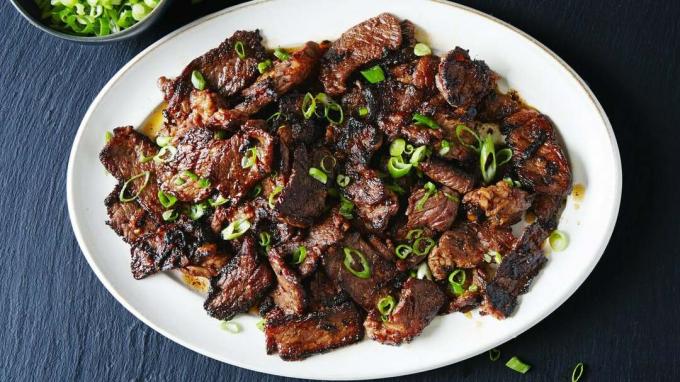
Beef is the ingredient that is present in virtually all South Korean dishes. Bulgogi is the most traditional way of preparing it. In it, the meat is cut into thin pieces and then marinated in ginger, soy sauce, garlic, sugar and other typical seasonings.
The cook must also grill the bulgogi at high temperatures to give it a smoky flavor. A side tip is lettuce leaves.
4. Hongeo-hoe

Here is an example of a very strong typical dish from Korea and it is made from fermented fish. Although Koreans are not the only ones in this area, the difference in this dish lies in the uric fish that passes through the skin. With fermentation, the acid is broken down and takes on the smell of ammonia.
5. tteokbokki

In addition to meat, rice is the main ingredient in Korean dishes and the natives make the most of it! Proof of this is tteokbokki, a soup made with cylindrical rice balls, anchovies, pepper, boiled eggs and chives.
6. sundae
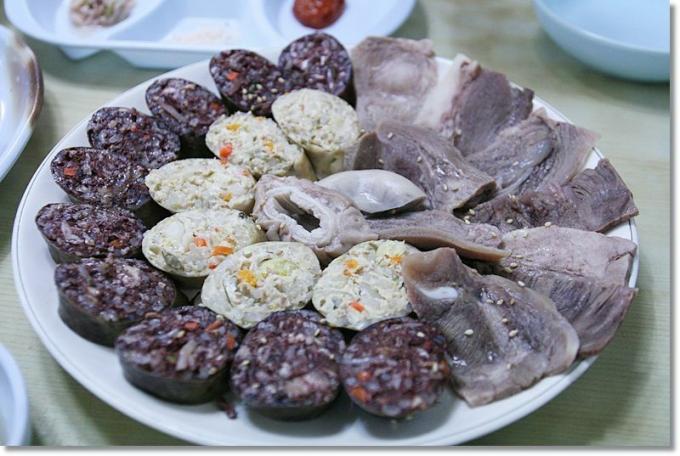
No, this dish has nothing to do with that ice cream you eat on hot days! The sundae is made with pork or beef intestines stuffed with barley, noodles, chives and blood. It looks very similar to sausage and can be accompanied by tteokbokki.
7. Kkotgetang

Another ingredient often found in South Korean dishes is seafood, especially crabs which, in kkotgetang, are the main ingredient. The aromatic and, of course, highly seasoned soup also includes fermented soy paste, zucchini, pepper sauce and radish.
8. Kalbi or Galbi

Once again, beef is the star of a Korean dish! Here, the preparation has the basis of beef ribs marinated in soy sauce. There are pork rib variations.
9. gimbap
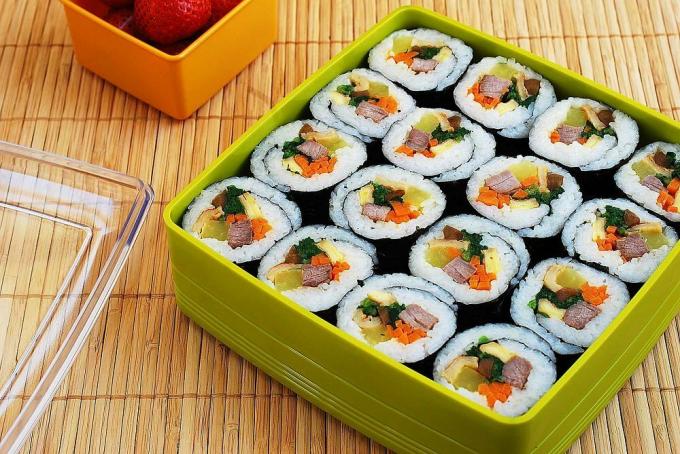
At first glance, you'll classify gimbap as a kind of sushi, which, indeed, it is! However, the preparation is simpler than its Japanese cousin – the rice ball is wrapped in seaweed and also receives various fillings. The most common are carrots and cucumbers, but variants are found with meat and eggs.
10. Jjajangmyeon
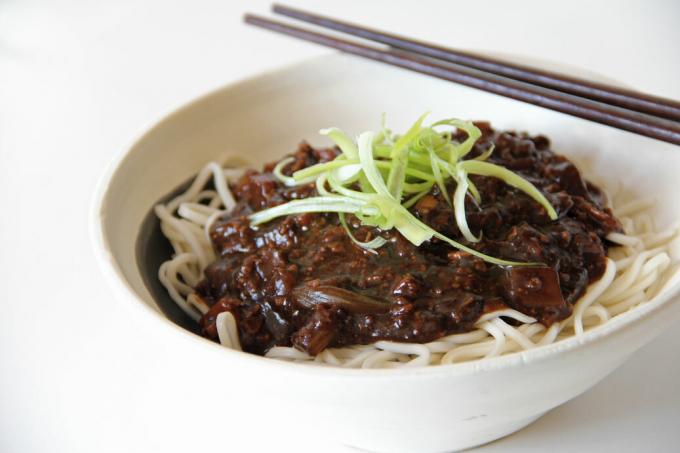
We already mentioned that South Korean dishes receive intense Chinese influence, right? jjajangmyeon is a classic example of this! The pasta, or noodle, is accompanied by black bean paste and pork belly, as well as zucchini and potatoes. Ah, the folder can be easily found in markets!
11. bibimbap

A real mix of rice with sauces, pepper paste, vegetables, meat and fried egg! Some cooks vary by inserting beef, chicken or pork.
12. manduguk

Do you know what is one of the explanations for so much spiciness in Korean dishes? The harsh winter! At times, the country faces sub-zero temperatures, which leads to the need for warm meals. One of them is manduguk, soup made with broth and meat dumplings, tofu and that typical Korean mix!
Recipes may call for tofu, seaweed, and rice flour.
13. Dakgangjeong
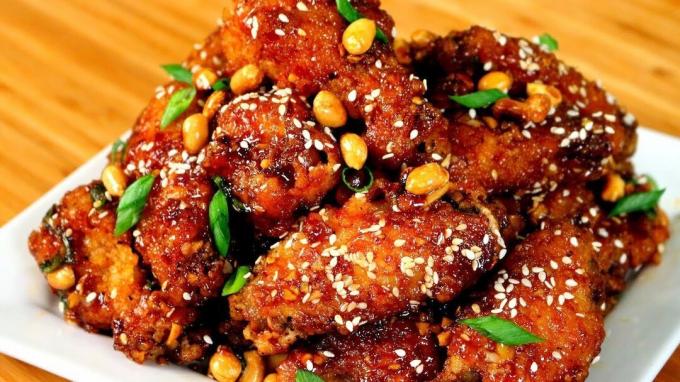
Do you like crispy fried chicken? Then you will love dakgangjeong! The wings and drumsticks are seasoned with salt, ginger and breaded with corn or potato starch. Of course, a typical sweet and sour sauce cannot be missing from this seasoning, right? Then, just fry it – twice – and serve it with more sauce, this time with soy and pepper.
14. Haemul-sundubu-jjigae

You already noticed that Korean soups came to deconstruct that image we have of light dishes with mild seasonings, right? And if the ones we've already described still haven't convinced you, meet haemul-sundubu-jjigae! More than a giant name, this dish brings a true fusion of ingredients!
The sundubu, for the most intimate, is made with anchovy broth, onion, garlic, mushrooms, beef and tofu. Yeah, the mix looks pretty exotic, but you'll see that all together makes this soup a wonderful dish!
15. Dol Sot Bi Bim Bap

The name is big, but the dish is very simple! It is a traditional Korean risotto made with boiled oriental rice, braised ground beef, onion and vegetables. The most common are eggplant, chayote, turnip, bean sprouts and zucchini.
16. Bibim Guksu

The bibim guksu is a dish made with very thin noodles, the somyeon, mixed with various types of vegetables, in addition to a spicy sauce. This one is prepared with ground pepper, garlic and gochujang. You can find some variations that include boiled egg and meat. But, be prepared: it is a very spicy dish!
17. ssambap

A typical Korean minced meat that has meat as the main ingredient. Side dishes vary according to the taste and creativity of the cook. Just can't miss the buns! There are those who use lettuce leaves, cabbage and seaweed to consume meat dumplings.
18. Juk

It's not just seasoned and full-bodied foods that people live in Korea! An example is juk, chicken soup or rice porridge. You know that hug in the stomach? The juk gives you! The dish is made with red beans, pumpkin and rice cakes. Light and very nutritious!
Korean typical drinks
1. soju

Beer and caipirinha are among the drinks most consumed by Brazilians at social events and bars, right? South Koreans drink soju, which is distilled much like sake but with a slightly stronger flavor. The preparation base is the same, that is, rice. However, its formula can bring spicy ingredients.
2. Makgeolli

Another very traditional Korean drink also known as Korean Rice Wine. Korean rice wine is sweet, has a milky consistency and can be consumed both in celebrations and in everyday life. You can find it in white or yellowish colors.
Korean typical desserts
1. hotteok

Dessert similar to pancakes that can be found in several versions. The traditional one is stuffed with honey, sugar, cinnamon and peanuts. In the south, especially in the Busan region, you can find dried fruit fillings. All very delicious!
2. green tea ice cream
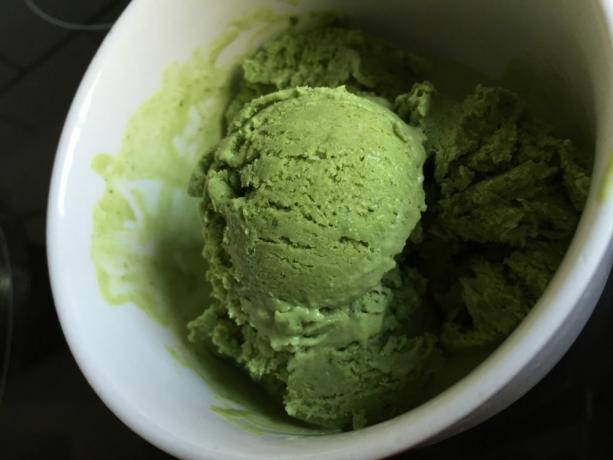
The ice cream is made with herbs grown near Suncheon and can be enjoyed across the country. You can try the traditional version and the green tea yogurt.
3. baesuk

Dessert is made with spiced pears in a ginger sauce. To soften the taste, a little honey is added, and it is also served chilled.


